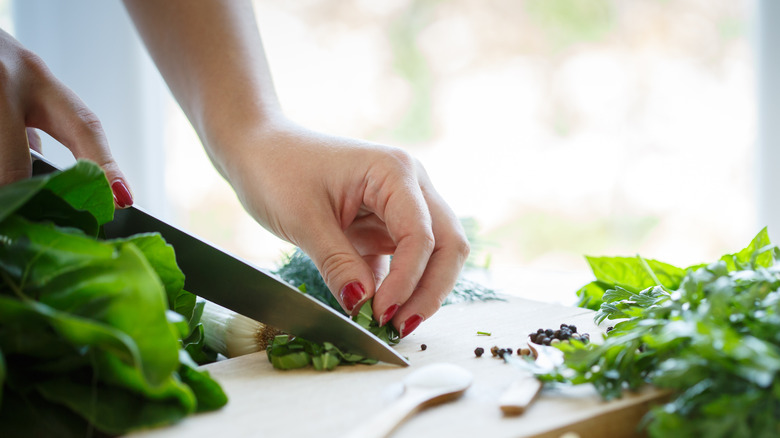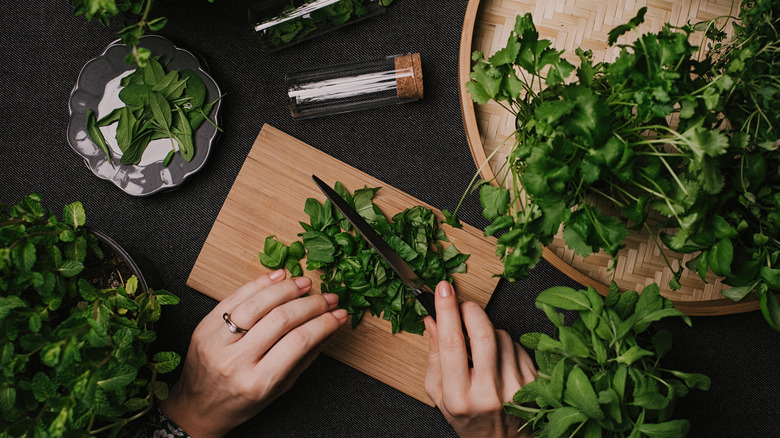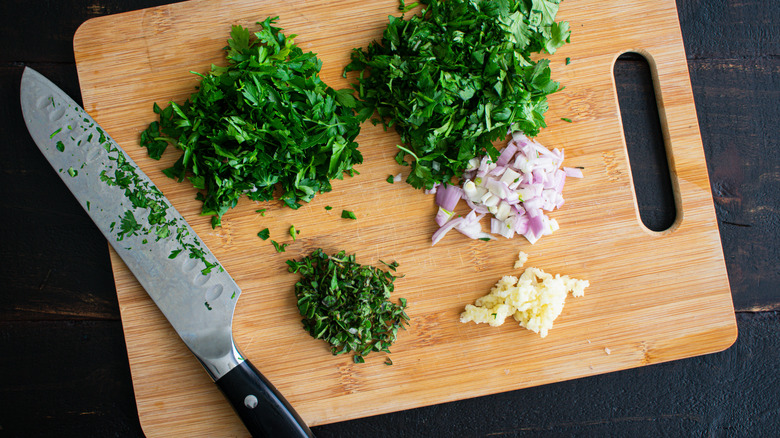This Is The Type Of Knife You Should Be Using To Cut Basil
We may receive a commission on purchases made from links.
Everyone knows the best marinara sauces contain basil. The freshness and pop of color basil brings to cuisine — including sauces, pasta, tea, and cocktails — is unmatched. There are many ways of cutting basil, including just tearing it with your bare hands, cutting it with a small paring knife, or going at it with a flexible filet knife. All of these knives will get the job done but none of it will do it optimally.
Different foods require different knives and different knife skills. A chef's knife is the best knife to use for cutting basil. The design of the chef's knife makes it a multifunctional machine. Chef's knives are characterized by a pointed tip and a blade with a sharp, prominent edge that curves gently downward. This design makes chef knives not only great for cutting basil and other fresh herbs (which it does well) but also the right tool for slicing, chopping, and dicing many other foods and vegetables.
Why use a chef's knife and how to pick the best one
Unlike many other hardy vegetables that can survive a lot of rough handling, basil is quite delicate. It can get bruised rather quickly and lose some of the fragrant aroma that makes it unique. To avoid that, it is best to stack individual basil leaves, roll them tightly, and then make quick work of them by slicing the stack with a chef's knife. This is called chiffonading. The balanced weight of the chef's knife makes it easy to maneuver while the sharp edge on the blade makes cutting the basil quick and easy with minimal bruising. A chiffonade leaves you with uniform basil strips to use in your soups, cocktails, and garnishes.
According to the New York Times, the Mac Mighty MTH-80 is the best chef's knife out there, but it is quite pricey, costing a whopping $144.95 on Amazon. Some other chef's knives that will give you the most bang for your buck are the Zwilling Professional S Chef's Knife and the Victorinox Fibrox Pro Chef's Knife.
Make sure you get a high-quality stainless steel knife. Stainless steel knives are long-lasting, not prone to rust, sharpen easily, and are easy to maintain. It is also important to check for fit. A good chef's knife should feel like an extension of your hand. You should be able to maneuver it deftly and, with practice, work with it quickly.
How do I care for my chef's knife and use it safely?
Because chef's knives are pricey, it is important to keep them in good shape so that they last you a long time. Giving your knives the proper care they deserve will keep the edge sharp and ready to give your basil and other vegetables the perfect cut.
Always keep your chef's knife sharp. As explained by the University of Rochester Medical Center, dull knives are more likely to slip and cause injuries because they need a lot of pressure to make them cut. Dull knives will also bruise delicate herbs like basil and cause them to discolor and lose flavor. You should also practice good knife skills to avoid injuries while using a chef's knife and always use your chef's knives on appropriate surfaces. The wrong materials can damage the blade of your knife and may lead to avoidable injuries. You don't want that.
Level up your basil-cutting game; use a chef's knife. Then put in the effort to keep it sharp and ready for action.


